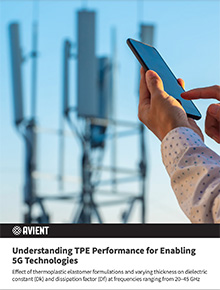Understanding TPE Material and Performance for Enabling 5G Technologies
Discover the effects of material formulations and thickness on dielectric performance

The 5th generation of cellular networks (5G) is an emerging technology that will allow consumers to be more connected than ever before by allowing faster data transfer rates with lower delays and latency. This means that while it can take up to six minutes to download a full-length movie in 4G, it can be done in as little as 15 seconds with 5G, and this is just the beginning. ¹
Plastic parts come into play for 5G by ensuring wireless signals can easily pass through the plastic material to minimize signal loss. High-speed signals are imperative in today’s culture through automobile communication, cell phone service, sending information at airports, and many other wireless needs. While rigid polymers are typically used for this because of their conductive and wireless properties, Avient has found additional value in low signal loss technology within its thermoplastic elastomer (TPE) portfolio. For 5G and beyond, signal transparency of materials will become more critical since those frequencies will require higher energy and less loss.
In this study, we set out to learn:
a) what effect do thermoplastic elastomer (TPE) formulations have on the attenuation (energy absorption) of a signal ranging from 20-45 GHz? And
b) what effect does the varying thickness of those TPE materials have on the attenuation (energy absorption) of a signal ranging from 20-45 GHz?
The ASTM D2520 standard is split into three parts: Part A for shorted transmission line method, Part B for waveguide cavities, and Part C for general examination. Using the test method reference from ASTM D2520 Part C, we generated repeatable data on the samples of four select formulations at the same four thicknesses, recording the average and median values for both dielectric constant (Dk) and dissipation factor (Df).
Download this white paper below to learn which TPEs were chosen, the methodology used, and the test results.
Sources
¹https://www.fcc.gov/5g-faqs

Download this white paper to learn more about the study to determine the effects of material formulations and thickness on dielectric performance.
Premium Content Download